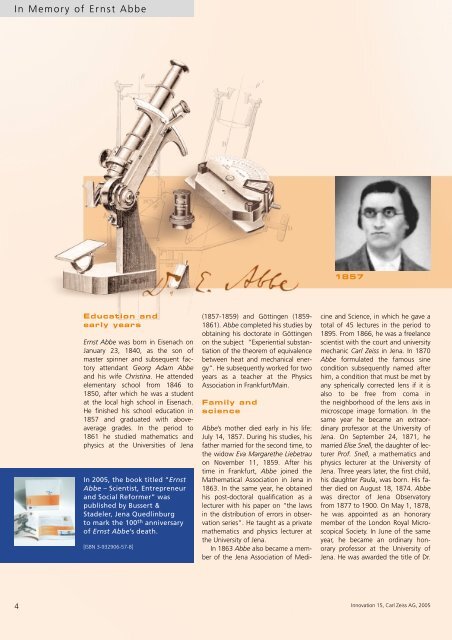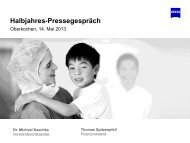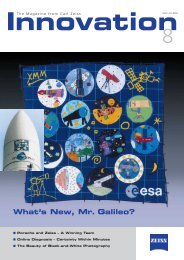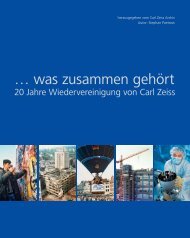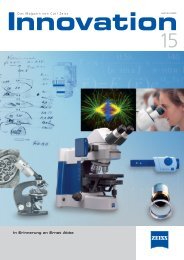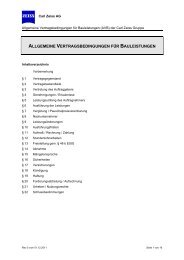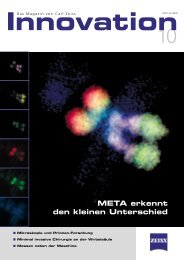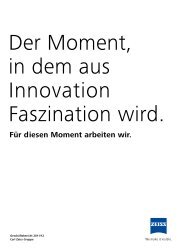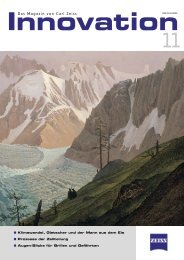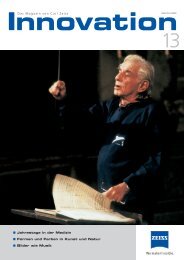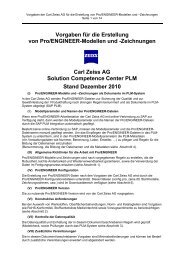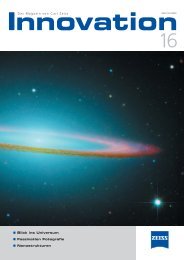Download PDF - Carl Zeiss
Download PDF - Carl Zeiss
Download PDF - Carl Zeiss
Create successful ePaper yourself
Turn your PDF publications into a flip-book with our unique Google optimized e-Paper software.
In Memory of Ernst Abbe<br />
4<br />
Education and<br />
early years<br />
Ernst Abbe was born in Eisenach on<br />
January 23, 1840, as the son of<br />
master spinner and subsequent factory<br />
attendant Georg Adam Abbe<br />
and his wife Christina. He attended<br />
elementary school from 1846 to<br />
1850, after which he was a student<br />
at the local high school in Eisenach.<br />
He finished his school education in<br />
1857 and graduated with aboveaverage<br />
grades. In the period to<br />
1861 he studied mathematics and<br />
physics at the Universities of Jena<br />
In 2005, the book titled “Ernst<br />
Abbe – Scientist, Entrepreneur<br />
and Social Reformer” was<br />
published by Bussert &<br />
Stadeler, Jena Quedlinburg<br />
to mark the 100 th anniversary<br />
of Ernst Abbe’s death.<br />
[ISBN 3-932906-57-8]<br />
(1857-1859) and Göttingen (1859-<br />
1861). Abbe completed his studies by<br />
obtaining his doctorate in Göttingen<br />
on the subject “Experiential substantiation<br />
of the theorem of equivalence<br />
between heat and mechanical energy“.<br />
He subsequently worked for two<br />
years as a teacher at the Physics<br />
Association in Frankfurt/Main.<br />
Family and<br />
science<br />
Abbe’s mother died early in his life:<br />
July 14, 1857. During his studies, his<br />
father married for the second time, to<br />
the widow Eva Margarethe Liebetrau<br />
on November 11, 1859. After his<br />
time in Frankfurt, Abbe joined the<br />
Mathematical Association in Jena in<br />
1863. In the same year, he obtained<br />
his post-doctoral qualification as a<br />
lecturer with his paper on “the laws<br />
in the distribution of errors in observation<br />
series“. He taught as a private<br />
mathematics and physics lecturer at<br />
the University of Jena.<br />
In 1863 Abbe also became a member<br />
of the Jena Association of Medi-<br />
1857<br />
cine and Science, in which he gave a<br />
total of 45 lectures in the period to<br />
1895. From 1866, he was a freelance<br />
scientist with the court and university<br />
mechanic <strong>Carl</strong> <strong>Zeiss</strong> in Jena. In 1870<br />
Abbe formulated the famous sine<br />
condition subsequently named after<br />
him, a condition that must be met by<br />
any spherically corrected lens if it is<br />
also to be free from coma in<br />
the neighborhood of the lens axis in<br />
microscope image formation. In the<br />
same year he became an extraordinary<br />
professor at the University of<br />
Jena. On September 24, 1871, he<br />
married Elise Snell, the daughter of lecturer<br />
Prof. Snell, a mathematics and<br />
physics lecturer at the University of<br />
Jena. Three years later, the first child,<br />
his daughter Paula, was born. His father<br />
died on August 18, 1874. Abbe<br />
was director of Jena Observatory<br />
from 1877 to 1900. On May 1, 1878,<br />
he was appointed as an honorary<br />
member of the London Royal Microscopical<br />
Society. In June of the same<br />
year, he became an ordinary honorary<br />
professor at the University of<br />
Jena. He was awarded the title of Dr.<br />
Innovation 15, <strong>Carl</strong> <strong>Zeiss</strong> AG, 2005


